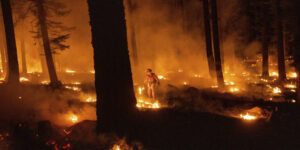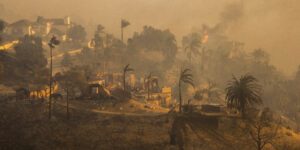After decades of struggle, the U.S. clean-energy business is booming, with soaring electric-car sales and fast growth in wind and solar power. That’s raising hopes for the fight against climate change.
All this progress, however, could be derailed without a massive overhaul of America’s antiquated electric infrastructure—a task some industry experts say requires more than $2 trillion. The current network of transmission wires, substations and transformers is decaying with age and underinvestment, a condition highlighted by catastrophic failures during increasingly frequent and severe weather events.
Power outages over the last six years have more than doubled in number compared to the previous six years, according to a Reuters examination of federal data. In the past two years, power systems have collapsed in Gulf Coast hurricanes, West Coast wildfires, Midwest heat waves and a Texas deep freeze, causing long and sometimes deadly outages.
Compounding the problem, the seven regional grid operators in the United States are underestimating the growing threat of severe weather caused by climate change, Reuters found in a review of more than 10,000 pages of regulatory documents and operators’ public disclosures. Their risk models, used to guide transmission-network investments, consider historical weather patterns extending as far back as the 1970s. None account for scientific research documenting today’s more extreme weather and how it can disrupt grid generation, transmission and fuel supplies simultaneously.
The decrepit power infrastructure of the world’s largest economy is among the biggest obstacles to expanding clean energy and combating climate change on the ambitious schedule laid out by U.S. President Joe Biden. His administration promises to eliminate or offset carbon emissions from the power sector by 2035 and from the entire U.S. economy by 2050. Such rapid clean-energy growth would pressure the nation’s grid in two ways: Widespread EV adoption will spark a huge surge in power demand; and increasing dependence on renewable power creates reliability problems on days with less sun or wind.
“Competition from renewables is being strangled without adequate and necessary upgrades to the transmission network,” said Simon Mahan, executive director of the Southern Renewable Energy Association, which represents solar and wind companies.
The federal government, however, lacks the authority to push through the massive grid expansion and modernization needed to withstand wilder weather and accommodate EVs and renewable power. Under the current regulatory regime, the needed infrastructure investments are instead controlled by a web of local, state and regional regulators who have strong political incentives to hold down spending, according to Reuters interviews with grid operators, federal and state regulators, and executives from utilities and construction firms.
Global Power Grids Face Biggest Test in Decades; Summer Blackouts Expected
Paying for major grid upgrades would require these regulators to sign off on rate increases likely to spark strong opposition from consumers and local and state politicians, who are keen to keep utility bills low. In addition, utility companies often fight investments in transmission-network improvements because they can result in new connections to other regional grids that could allow rival companies to compete on their turf. With the advance of green energy, those inter-regional connections will become ever more essential to move power from far-flung solar and wind installations to population centers.
The power sharing among states and regions with often conflicting interests makes it extremely challenging to coordinate any national strategy to modernize the grid, said Alison Silverstein, an independent industry consultant and former senior adviser to the U.S. Federal Energy Regulatory Commission (FERC).
“The politics are a freakin’ nightmare,” she said.
The FERC declined to comment for this story. FERC Commissioner Mark Christie, a Republican, acknowledged the limitations of the agency’s power over the U.S. grid in an April 21 agency meeting involving transmission planning and costs.
“We can’t force states to do anything,” Christie said.
The White House and Energy Department did not comment in response to detailed questions from Reuters on the Biden administration’s plans to tackle U.S. grid problems and their impact on green-energy expansion.
The administration said in an April news release that it plans to offer $2.5 billion in grants for grid-modernization projects as part of Biden’s $1 trillion infrastructure package. A modernized grid, the release said, is the “linchpin” of Biden’s clean-energy agenda.
Disasters Expose a Broken Grid
Recent extreme weather events have revealed the weaknesses in U.S. power infrastructure. The New Orleans power network was doomed to fail before Hurricane Ida battered the region with winds of up to 150 mph. Built in the 1970s, when such superstorms were less common, much of the network had been engineered to withstand maximum winds of just 95 mph, according to regulatory filings reviewed by Reuters. After Ida, the blackout lasted weeks.
Weather events and related fuel-supply shortages were the primary cause of the sharp rise in U.S. outages, according to data compiled by the North American Electric Reliability Corporation (NERC), a grid regulator. Outages between 2015 and 2020 averaged 9,656 annually, more than double the average of 4,609 during the previous six-year period, the data examined by Reuters show. NERC does not have comparable data from previous years.
That deteriorating performance coincided with a surge in natural disasters: The United States experienced 229 weather events that each caused more than $1 billion in damage between 2002 and 2021, compared with just 94 such events from 1980 to 2001, according to the National Oceanic and Atmospheric Administration’s National Centers for Environmental Information. (The damage totals are adjusted for inflation over the period.)
As the weather gets wilder, the grid gets older. The U.S. Department of Energy found that 70 percent of U.S. transmission lines are more than 25 years old in its last network-infrastructure review in 2015. Lines typically have a 50-year lifespan. The average age of large power transformers, which handle 90 percent of U.S. electricity flow, is more than 40 years. Transformer malfunctions tend to escalate at about 40 years, according to research by reinsurance provider Swiss Re.
Part of the problem is that the organizations charged with overseeing regional power grids don’t see these disasters coming, according to power industry consultants and a Reuters review of regulatory filings and grid operators’ public disclosures. The risk models used by all seven regional operators show they typically consider decades of historical data and assign each year’s weather an equal probability of occurring in the future. Utilities use those models to guide their grid investments, which state regulators typically must approve.
Climate change has made such models obsolete, said Derek Stenclik, founder of Telos Energy, a power-analytics and engineering firm, in testimony last year to the FERC. “The use of historical weather observations,” he said, “may no longer be representative of future conditions.”
The grid operators for California, the Midwest, New England, New York and Texas each told Reuters they have recently increased efforts to plan better for weather disasters, even if they have only a small chance of happening. The other two regional grid operators, the Southwest Power Pool and the PJM Interconnection, which covers a group of eastern and midwestern states, did not respond to comment requests.
In early 2020, the California Independent System Operator (CAISO) relied on historical weather patterns to calculate a 0.15 percent chance that the state would experience blackouts during the peak summer demand season.
Sweltering heat that summer, accompanied by an outbreak of some of the region’s worst recent wildfires, caused power plants and transmission equipment to fail just as homes and businesses cranked up their air conditioners, triggering some of California’s worst outages in decades.
The fires disabled transmission systems that could have drawn power from other regions. California’s increasing reliance on renewable energy contributed to the problem: Outages spiked as solar’s contribution to the grid plunged after the sun went down.
Wildfire disruptions to transmission lines have become increasingly common, but CAISO did not assess fire risks to its network. The grid operators told Reuters that fire damage is too complicated to predict.
A year-and-a-half later, the Electric Reliability Council of Texas (ERCOT) was caught off guard by a prolonged deep-freeze triggering a blackout across much of the state. Nearly 250 people died, most from hypothermia, according to the Texas Department of State Health Services. The two-week cold snap was caused by an unusual southward shift in polar airflows that some researchers have linked to climate change.
ERCOT’s risk modeling before the February 2021 freeze had concluded that the state would have about 40 percent more power capacity than it needed for winter. It never anticipated the extended cold, and its model did now capture how utilities had failed to properly winterize their equipment.
Instead, ERCOT had a massive shortfall of available power as temperatures plunged and heat demand spiked. Several million Texans were left without water and electricity for days.
Jana Langley, a 38-year-old accountant from Mesquite, Texas, said her father barely survived after he “nearly froze to death and had several mini-strokes.”
“We shouldn’t have to worry about people dying because someone flips off the electric switch,” she said.
ERCOT said in a statement that it has implemented reforms to avoid a repeat of the blackout, including improvements to its extreme-weather risk modeling.
No One in Charge
Upgrading the grid won’t be cheap or easy. Consultancy Marsh & McLennan estimates that more than 140,000 miles of U.S. transmission lines will need to be replaced by 2050, which alone could cost $700 billion. In all, the fixes and upgrades needed to maintain “a transmission system capable of dealing with the nation’s future needs” will cost more than $1 trillion, the 2020 study concluded. A Princeton University study the same year estimated much higher costs—about $2.4 trillion by 2050.
This is a massive to-do list. And it belongs to no one in particular.
FERC and NERC are the top regulators of America’s electricity system. FERC regulates power prices, while NERC enforces certain reliability standards, having issued over $2 billion in fines since a massive regional blackout in 2007. But neither has the authority to fix or upgrade the U.S. grid problems to match Washington’s green-energy ambitions.
“We really don’t have anyone in charge,” said Rob Gramlich, president of Grid Strategies LLC, a Washington D.C.-based energy consulting firm.
Responsibility for grid maintenance, upgrades and inter-regional connections is shared among state and local regulators, utility companies and the seven grid operators. The operators have little independent power over modernization; rather, they are simply associations whose members are largely utilities and local regulators.
That system is failing because none of these players individually have the power or the responsibility to maintain the U.S. grid in the national interest, said Ari Peskoe, director of the Electricity Law Initiative at Harvard Law School. Rather, he said, they tend to prioritize provincial interests, typically utility profits or low consumer rates.
Members of the Midcontinent Independent System Operator (MISO), which oversees transmission infrastructure for utilities in 15 U.S. states and the Canadian province of Manitoba, have been in an ongoing battle over how they will share costs of transmission expansions and improvements. The disputes have blocked progress on regional projects.
The Public Service Commission in Louisiana, part of the MISO region, has objected in recent years to paying for new transmission lines to handle renewable generation in the northern part of the region, arguing the projects don’t benefit the state. Louisiana commission member Eric Skrmetta has repeatedly threatened to withdraw the state’s major utilities from MISO over the issue.
Skrmetta and other commissioners have also defended low investment in new transmission and other infrastructure in MISO’s southern territory by arguing such projects aren’t needed to ensure supplies of low-cost energy in Louisiana.
Entergy Corp, the dominant utility in MISO’s southern region, said it supports grid improvements as long as they benefit consumers. It opposes projects serving MISO’s northern territory, however, because there are limited connections between the two regions that could bring lower-cost power to Louisiana, the utility said. The company said it is also considering investments of billions of dollars to harden its infrastructure after Hurricane Ida.
Entergy’s ENPAC Louisiana, the company’s political action committee in the state, has been Skrmetta’s second-largest contributor, having contributed about $34,000 during his three successful campaigns for public service commissioner, according to Louisiana campaign finance disclosures.
Skrmetta did not respond to requests for comment.
Trapped Electrons
The administration’s climate agenda would add vastly more wind and solar power to the creaky U.S. grid. That would exacerbate the transmission network’s challenges because of the inherent unreliability of these renewable sources. Unlike coal, for example, wind and sunshine can’t be stored for ready use in power emergencies.
The renewable power expansion would also coincide with a massive demand surge from electric cars. The U.S. Energy Department estimates Americans will use 40 percent more electricity by 2050 with widespread EV adoption.
“We are more reliant on electricity than ever before, and our tolerance for outages is lower than ever,” said John Moura, NERC’s director of reliability assessment and system analysis.
Another steep challenge: getting renewable power to population centers. Locating massive wind farms and solar facilities near cities and suburbs brings its own set of political challenges. Solar installations, which require vastly more land than comparable fossil-fuel facilities, are already facing intense political opposition in rural America from residents who say they mar the local landscape and culture as developers buy up farmland.
Locating renewable facilities in far-flung locales, in turn, requires reliable nationwide connections to move the power around the country. Right now, much of the available renewable power is trapped in various regions.
In one striking example, wind power regularly meets more than 75 percent of the demand for electricity in the 14-state Southwest Power Pool, stretching from North Dakota to Oklahoma. But limited transmission lines connecting this region to the rest of the nation means all that clean power is frequently bottled up by network congestion.
“We can send a rover to Mars, but we can’t send an electron to California from New York,” U.S. special climate envoy John Kerry told the CERAWeek energy conference in Houston in March.
No one is addressing that problem, according to a March 2022 report produced for the U.S. Department of Energy’s Office of Electricity. The report, from Boston-based consulting firm the Brattle Group, concluded: “Essentially no major interregional transmission projects have been planned and built in the last decade.”
The report blamed federal and state policymakers, along with regional grid operators, for “insufficient leadership.”





















 E&S Market Sees 21% Compound Growth Within Past 5 Years: Conning
E&S Market Sees 21% Compound Growth Within Past 5 Years: Conning  Loss-Free Property Cat Rates Fall 5-15% as Reinsurer Appetite Grows: Guy Carpenter
Loss-Free Property Cat Rates Fall 5-15% as Reinsurer Appetite Grows: Guy Carpenter  California Insurers Required to Increase Home Coverage in High Risk Wildfire Areas
California Insurers Required to Increase Home Coverage in High Risk Wildfire Areas  Surviving the ‘Silver Tsunami’: Closing the Talent, Skills Gap in Underwriting
Surviving the ‘Silver Tsunami’: Closing the Talent, Skills Gap in Underwriting 




